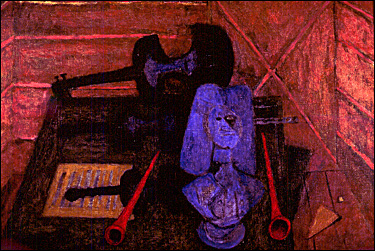
Tamayo’s signature richness and brilliance of color and complex textures are evident in this balanced, musically inspired still life Homenaje a Bach (Homage to Bach).
Homenaje a Bach, 1949. Rufino Tamayo (Mexican). Oil on canvas: 28" x 42". Gift of Mr. Gilbert M. Denman, Jr.
Tamayo was not interested in following the representational style favored by most of the early Mexican muralists. He responded instead to abstract modernism and to the pre-Columbian art of his native Oaxaca. In 1951, Tamayo returned to Mexico after numerous trips abroad to accept a commission for two murals at the Fine Arts Palace. He completed several murals in Mexico, as well as works in Massachusetts, Paris, and Montreal.
To a new generation of Mexican artists in the 1950s, Tamayo represented an alternative to the social realist style of the muralists. These artists began a movement known as the Ruptura. In Oaxaca in the 1980s, the movement referred to as magic realism was also inspired by his work.
In 1981 the Rufino Tamayo Museum of Contemporary Art opened in Mexico City. Tamayo's original work exemplifies an international spirit imbued with a deep sense of ancestral roots and personal vision. He was recognized internationally with several prestigious awards.